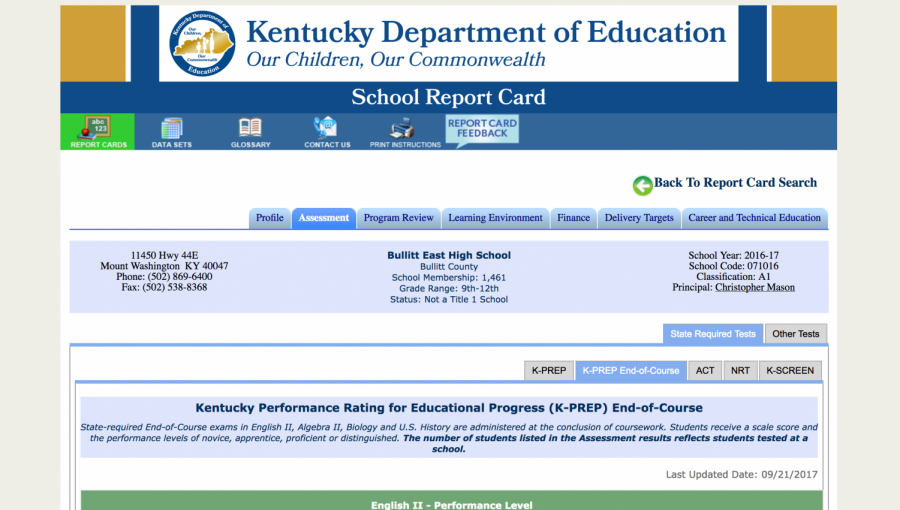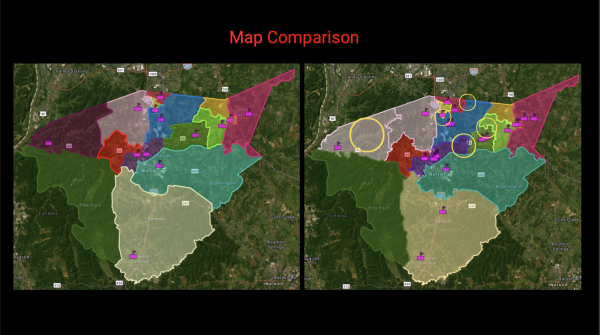And the Results Are In
This is what students can expect to see when visiting the Report Card feature of the KDE’s website. Score reports for the previous school year’s EOC’s are available under “Assessment,” then “K-PREP End-of-Course.”
The breakdown of released testing scores and what’s being changed in statewide testing.
Data from last year’s EOC testing results were recently released to the public, cuing an avid analyzation of what the information is telling us about students and learning.
EOC testing scores are easy to access, and can be accessed by anyone, anywhere. Staff and faculty at Bullitt East are taking advantage of this to meet and discuss what the results tell us. Teachers, however, are worrisome of the future, as EOC testing is getting a total makeover.
On Sep. 28, principal Chris Mason was finally able to announce the release of official data for EOC test scores, also known as End-of-Course assessments. The Kentucky Department of Education’s website features the exact same data as all faculty and staff sees, and can be accessed through their “School Report Card” feature.
The School Report Card feature provides a complete analysis of what End-of-Course data tells us. On the page you can find scores broken down by race, gender, gifted and talented versus not, as well as a plethora of other categories. The website also provides a comparison of Bullitt East’s scores versus the district and entire state.
To break down what the scores tell us, one can first see that students are tested in English Ⅱ, US History, Algebra Ⅱ and Biology. In all of these categories, at least 40 percent of students tested at a proficient level.
Overall, students scores earned Bullitt East a projected 78.44 overall accountability score, which puts the school at a distinguished rating for the third year in a row. The keyword in this sentence, however, is projected. Accountability scores were not calculated this year, so the number was predicted by Jan Stone, the director of Assessment, Data and Research at the board.
More specifically, students had the highest scores in On-Demand writing and math, scoring a respective 82 and 75 percent. However, the news isn’t all good. In all tested categories, scores went down from last year; social studies experiencing a 22 percent drop. “I think the reason for this is probably a turnover in staff, and just the fact that it compares classes,” said Larry Steinmetz.
On the last scheduled teacher-work-day, teachers sat down and discussed these raw numbers. They analyzed to find strengths and weaknesses, which has been the routine for a number of years now. This year, freshman principal Kari Stewart streamlined everything into a powerpoint for teachers to view. The powerpoint featured information on graduation scores, testing scores, college and career ready scores and GAP scores.
GAP scores are an important piece in the EOC testing puzzle. GAP scores represent low-income students and special education students here at Bullitt East. Results found that the highest areas of testing for these students were in On-Demand writing and math, and the lowest areas of testing science and reading. Reading also experienced a significant drop in scores, along with social studies.
After looking at the data, teachers worked on how to improve these scores, answering some basic conversation starters listed in the powerpoint such as “What does the data tell us?” and “What do we see as areas for growth?”
With this mixed feedback, EOC is also coming back full swing with some big changes, which is getting some even bigger mixed feedback. Starting this school year, the makers of the EOC are saying out with the old, and in with the new.
Instead of getting back an overall accountability score, students will be rated with a star system. This star system represents the school as a whole, and will include all aspects of the accountability system.
These changes are letting some Bullitt East students off the hook, as this year’s EOCs are just “field tests,” which simply means that the creators are testing their own test. Results most likely will not even been reported back to teachers. Students in US history will be let off the hook even more, as a field test for the subject won’t be prepared in time for testing season, leaving the Department of Education with no test at all for students.
A lot of minor changes are still up in the air, and the majority still don’t fully know what the new face of End-of-Course testing will look like. “I thought the EOC’s were always easy, but I can imagine teachers might be a little stressed about what exactly they should be teaching,” said senior Tristen Preston, who has taken the US history and Algebra Ⅱ EOC.
“I’m expecting mostly format changes,” said Laura Pierce, English Ⅱ teacher. Steinmetz agreed, saying that the new changes will definitely come with a learning curve.









